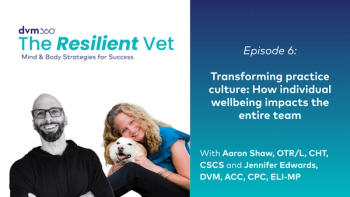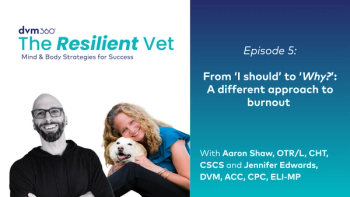
How to chase that runners high in a busy veterinary life
Part three in this series looks at using exercise to fight stress, create happiness and improve your job satisfaction in veterinary practice.
Former veterinary practice owner and practice management consultant Steve Noonan, DVM, continues his quest to share the mindfulness, happiness and self-care tips that turned his life around with veterinarians and veterinary team members. This column explores physical fitness. Join us next month for tips on putting mindfulness to work for you. And to see Dr. Noonan live on video and in person, check the related links below.
If you want to know whether exercise can help your brain, let's dig into some research.
Let whatever moves you, move you! Your brain will thank you later.In his book Spark, neurologist John Ratey chronicles an experiment in the Naperville, Illinois, school district in which 19,000 kids were given a new choice by their physical education teachers outside of conventional physical education: “vigorous activity.” The result, over a number of years, was that the Naperville kids outperformed children in the rest of America, not only in standardized fitness tests but academically as well. In fact, in a standardized test administered to school kids worldwide, the Naperville students were first in science and sixth in math. Students nationwide ranked 18th in math and 19th in science.
Exciting new research like this in the fields of neuroscience and sports medicine is showing that regular, vigorous exercise has the capacity to positively impact neural stem cells and act as a super fertilizer for existing neurons and neural networks. Exercise can make you smarter and even aid in the management and prevention of anxiety, depression and Attention Deficit Hyperactivity Disorder (ADHD).
What courts as vigorous exercise?
For an average person, the maximum heart rate should be 220 minus your age. If you're 40, your maximum heart rate would be 180. To be considered vigorous, activity must sustain a heart rate of 80 to 90 percent of one's maximum heart rate. For a 40-year-old, that's a heart rate of 144 to 162 beats per minute. The heart rate should be sustained for a minimum of 20 minutes at least three times per week.
At this level of exercise you should be somewhat short of breath and unable to sing the words to a song. As fitness develops the amount of time you can sustain this vigorous rate of exertion longer. Following the advice of a trainer is the best way to develop an increased capacity for exercise.
Chasing a healthy high-and healthier neurons
The feeling of well-being created from exercise is a result of the release of endorphins, which are part of a class of about 40 synthetic opioids the body can release in response to various stimuli. Exercise increases blood flow, delivering oxygen and glucose to feed your hungry neurons. The sense of mastery over your environment and the ability to take control of your destiny also contribute to the well-being created by regular exercise.
There are a host of other important proteins in the brain that are critical to brain development and performance that are enhanced by vigorous exercise, such as Brain-Derived Neurotrophic Factor or BDNF. Production of BDNF has been shown to increase threefold after vigorous exercise. The benefits of BDNF are virtually miraculous. Nerve cells live longer and the dendrites are “bushier,” which means there are more potential synaptic connections. Neurotransmitters are more strongly bound at synapses resulting in more effective nerve conduction. In the face of high levels of BDNF, stem cells survive better and become functional neurons at a higher rate. Myelin is thicker on axons, resulting in better nerve conduction. Neurotransmitters like serotonin are produced in greater volumes. It's no wonder the exercise-induced benefits of BDNF result in higher intellectual abilities.
The Naperville experiment sparked a flurry of research into the other benefits of exercise. It's now known that exercise is as effective as medication for anxiety and depression. It certainly can serve to augment or minimize pharmacotherapy. I love the idea that we can choose exercise over drugs or can minimize dosages based on our response to exercise.
Now let's dive into getting inspired, planning for more exercise and making your exercise count ...
My plan for more exercise and better brain function
1. Put your discipline to work for you
Once you create an intention, your mind will find a way to make it work.
2. Make a plan
Develop a realistic schedule, write it down in your journal and stick to it. Plans that are written down and kept top-of-mind are achieved with a much higher frequency than those we keep nestled in our own mind.
3. Start easy, but start!
It's critical to avoid injury when you start out on an exercise plan. The result will not only be detrimental to your body but also to your mind, giving you the impression you've “failed” at making an importance life change yet again. It may help for you to join a gym or get an instructor.
Your intention should be to start as soon as soon as possible, without risk of injury. (You want to take advantage of all that discipline and determination from Step 1!) As your fitness level increases, a six-times-a-week regimen of even small amounts of vigorous exercise (remember 20 minutes three times a day was a magic number?) will serve you, your body and your mind very well.
4. Start early
The most pronounced mental benefits of exercise come in the first few hours following your routine. Early morning workouts set you up for success and are a good reason to get out of bed.
5. Do what you love
Let whatever moves you, move you! Have fun as you simultaneously improve your mental and emotional health: power walking, dancing, martial arts, running, tennis, soccer, and on and on. There really is no limit!
6. Add variety
There's no rule that says you can't mix jumping rope with swimming, boxing or tango classes. The key is to achieve the heart rate for the prescribed period of time necessary for optimum mental health.
7. Be vigorous
This is not a stroll in the park, though light exercise has other mental benefits. Commit to the target heart rate for the desired time period.
8. Log your results in your journal
Maintaining a written record serves as a testament to your commitment to yourself. Its strength day after day. Be sure to note how you felt both immediately after and for the remainder of the day.
9. Be SMART
You've heard it before, but it bears repeating. Set goals that are Specific, Measurable, Achievable, Reasonable and Time-specific. A scheduled program of vigorous exercise with defined parameters does exactly this.
Most important, let me know how you're doing. If you need a vote of confidence or you have followup questions about how fit this exercise into your busy life, I'm always just an
High levels of stress are a constant for us as veterinarians. Vigorous exercise is a proven antidote to battle stress.
Dr. Steve Noonan, CPCC, is a veterinarian, management consultant, counselor, mindfulness instructor and professional life coach living in Guelph, Ontario, Canada.
Newsletter
From exam room tips to practice management insights, get trusted veterinary news delivered straight to your inbox—subscribe to dvm360.





